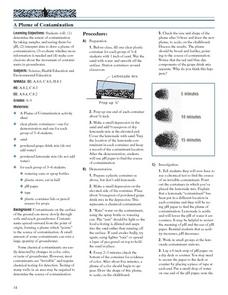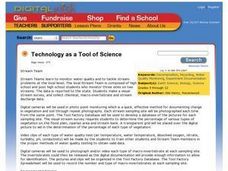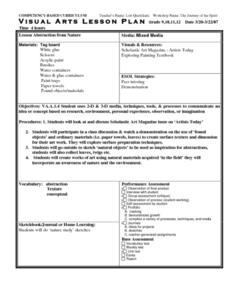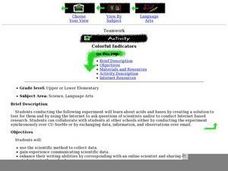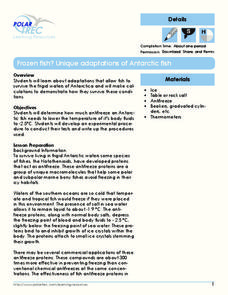Curated OER
More on Conduction and Convection
Why do some items feel colder when they are the same temperature? How should you keep your soda cold? What makes the wind blow? These are just some of the things middle schoolers discover when completing a activity on...
Curated OER
Feel the Wonder
Students describe why clean water is important and how humans effect the quality of water in a community. They identify efforts in their community to keep the water clean. They participate in a water restoration movement in their area...
Curated OER
The Earth around Us: Air, Water & Soil
Students recognize that science is everywhere. In this scientific method lesson, students experiment with height and record their experiment using the scientific method. Students must identify each step of the...
Curated OER
Beverage Tests
Students investigate the pH of a liquid. In this middle school mathematics/science lesson, students collect and analyze data regarding the pH of various liquids. Students display their data in various types of graphs as they...
Curated OER
A Plume of Contamination
Pupils perform an experiment/investigative simulation regarding the movement of contaminants in groundwater. They test the pH of three water samples, and then use their reasoning skills to determine the source of an invisible...
Curated OER
Understanding the pH Cycle within the Aquarium
Students discuss places they have been where the air seemed hard to breathe. They discuss if they could "see" the humidity or smell. Students discuss ways this might relate to the fish in the aquarium. The teacher introduces pH and how...
Curated OER
Separation of Mixtures and Compounds For K Through 12
Students explore mixtures and compounds. In this activity, students do an experiment to distinguish between mixtures and compounds. Students complete ten different phases of the experiment testing many different substances. Students will...
Curated OER
Sink or Float?
Students examine how weight and balance can effect if an item sinks or floats. They listen to the book "Who Sank the Boat?" by Pamela Allen, and discuss how the smallest animal sank the boat. Students then conduct an experiment in...
Curated OER
Qualitative Analysis and Ksp Calculations
In this compounds worksheet, students determine which anion is present in solution from the results of testing with various reagents. Students compare the solubility of different compounds in water. This worksheet has 7 fill in the blank...
Curated OER
Don't Get Caught!
In this fish worksheet, students read about fish and write about how they can help fish. They write about how they can save fish, fish migration, fish getting sick, and testing for pollution in water.
Curated OER
Fish
This short activity, with a reading passage and questions, could be part of a test preparation activity. Through answering the 10 questions students practice comprehension and vocabulary skills.
Curated OER
Comparative Stream Quality
Students examine water quality on a nearby stream. They collect water samples and test for various factors, including any contamination from the treatment plant, and present their information in a Powerpoint presentation.
Curated OER
Not a Drop to Drink
Young scholars design an experiment to determine which liquid is water. In this chemistry lesson, students perform the experiment as outlined in their design. They record observation and formulate conclusion.
Curated OER
Technology as a Tool of Science
Students monitor streams, take stream surveys, collect chemical and macro-invertebrate and stream discharge data. Using a digital camera, students observe the percentage of various types of vegetation on the flood plan, riparian area and...
Curated OER
Landfill Leachate
High schoolers become aware that everything we do on and to the surface of the earth affects our water.
Curated OER
Weathering and Erosion
Students examine the similarities and differences between weathering and erosion. They participate in a lab in which they test the effects of different materials when exposed to weathering and erosion. They record their observations.
Curated OER
The Journey of the Spirit
Students discuss Scholastic Art Magazine issue on 'Artists Today' . They participate in a class discussion & watch a demonstration on the use of 'found objects' and ordinary materials (i.e. paper towels, leaves) to create surface...
Curated OER
Colorful Indicators
Young chemists learns about acids and bases by coming up with a solution that will test for each. They also access the Internet to perform research. They are encouraged to contact students in other schools by conducting the experiment at...
Curated OER
Evaporation Inquiry
The evaporation of water and what happens to it as it travels through the water cycle are the focuses of this lesson. The evaporation of water seems like a "magical" process to people of all ages. This lesson takes away the mystery, and...
ARKive
Plants
Here is a one-hour activity that helps learners remember the parts of plants. Not only will the class learn about plant parts, they'll also discuss seed dispersal and plant growth. A celery experiment is used to show how plants obtain...
Curated OER
Cup Capacity Tool: Measuring Cup
Students examine containers and their capacity. They fill a one-cup measuring cup with water and pour cups of water into other containers. Through observation, students discover how many cups make a pint, and how many teaspoons make a...
Polar Trec
Frozen Fish? Unique Adaptations of Antarctic Fish
Some fish contain proteins that act like antifreeze in order for them to live in the frigid waters of Antarctica! High schoolers determine how much antifreeze a fish needs to lower its body temp to -2.5 degrees. Teachers act as a...
Curated OER
Evidence of Photosynthesis
Hands on science is the way to go! Learners conduct a lab experiment to help them explain how plants make food through photosynthesis. They test for the presence of starch in leaves using iodine solution and identify the basic things...
Curated OER
Sediment Sleuths
Are you looking for a good, solid lesson on sedimentary rocks? This one, produced by the Illinois State Museum, is just such a lesson. Middle schoolers identify common rocks and minerals by analyzing sediments from local water sources....






